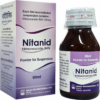Description:
ndications
- Diarrhoea caused by Cryptosporidium parvum and Giardia
- Amebiasis and helminth
Pharmacology
Nitazoxanide is a biosynthetic antigen for oral administration. The antigenic activity of nitazoxanide is thought to interfere with the enzyme Pyruvate Ferredoxin Oxido Reductase (PFOR)-dependent electron transfer reaction. This reaction is essential for protozoa anaerobic energy metabolism. Nitazoxanide and its metabolite, tizoxanide, act in vitro to inhibit the growth of spores and oocytes of Cryptosporidium parvum and the nutrients of Giardia lamblia.
Dosage & Administration
Age 1-3 years : 5ml (100 mg) twice daily for 3 days
Age 4-11 years : 10ml (200 mg) twice daily for 3 days
Age 12 years : 500mg or one tablet twice daily for 3 days
Nitanid should be taken with food. Or, as directed by the registered physician.
Interaction
Nitazoxanide is highly bound to plasma protein (>99.9%).Therefore, caution should be used when administering Nitazoxanide concurrently with other highly plasma[1]protein bound drugs.
Contraindications
Known hypersensitivity to Nitazoxanide or any other ingredient in the formulations.
Side Effects
Nitazoxanide is generally well tolerated. However abdominal pain, diarrhoea, vomiting and headache have been reported rarely.
Pregnancy & Lactation
The US FDA pregnancy drug category for nitazoxanide is B. However, there are no adequate and well-controlled studies in pregnant women. Since animal reproduction studies are not always predictive of human response, this medicine should be used during pregnancy only if clearly needed. Nitazoxanide has been shown to be excreted in human milk. Therefore, caution should be exercised when nitazoxanide is used during lactation.
Precautions & Warnings
Nitazoxanide should be administrated with caution to patients with hepatic, renal and biliary disease.
Therapeutic Class
Anti-diarrhoeal Antiprotozoal
Storage Conditions
Keep in a dry place away from light and heat. Keep out of the reach of children.







Reviews
There are no reviews yet.